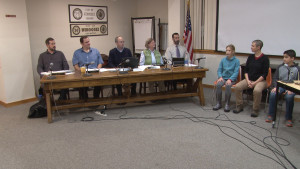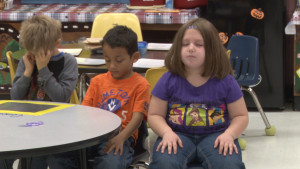(expired) Sharing $30,000 Grant for Mindfulness
 Please note that this grant has expired and no longer available.
Please note that this grant has expired and no longer available.
We are happy to announce that we can now help more people bring mindfulness into schools in a powerful new way thanks to a generous grant from the 1440 Foundation.
A year ago we embarked on an innovative plan to collaborate with mindfulness teachers and organizations. The idea was simple. Many teachers and organizations have developed successful mindfulness lessons. We’ve developed a successful online teaching platform. Why not combine the two so more educators can reach more students via technology?
We call this collaboration our Mindful Educator Partnership. Teachers, schools, and mindfulness organizations can partner with us to create an online app customized with their teaching materials and logo. That way schools can have their own mindfulness app with the voices of local guidance counselors, teachers, and students. The partnership is also here to give individual mindfulness teachers (and other mindfulness organizations) a powerful online platform to house their teachings.
Thanks to 1440 Foundation’s generous grant, we can dramatically lower the cost of this partnership. We’d love to work with you, so please contact us to learn more.
Hello world!
We are very excited to debut our new website!
It’s been a journey of several months with plenty of meetings about design, content, photo selection, and deadlines. We wanted our website to reflect our values, goals, and the wisdom we’ve gained from years of teaching mindfulness in the classroom. We couldn’t be happier with the outcome.
Before officially launching into the redesign, we had many talks about how to accomplish our website goals, but we couldn’t have done this without the good work of the developers at PowerUp. They helped us to clarify how we could best represent Modern Mindfulness through design and content. We are pleased to have a website that shows who we are and where we are going.
Please enjoy exploring our lovely new website, and please get in touch with us if have any questions or want share any stories about mindfulness in schools.
7 Tips for Hot and Cold Mindfulness

April Light by Laura McKelvie
It was a strange winter here in Vermont.
New to the area, I was told to expect many feet of snow on the ground until late April or early May. While gray clouds hinted that an infamous Northeast blizzard was just around the corner, we were never truly inundated. Periodic warm days often melted the snow completely. A bout of blue skies and the intoxicating smell of fresh grass in late March left me confident there would be no more winter. But early April brought enough snow to shovel and I snapped the photo here to commemorate my faulty prediction.
I reflected then about how this on-again off-again winter provided a perfect metaphor for my mindfulness practice. Lately it’s passed through periods of hot and cold, so to speak. Some days my practice has a momentum of its own—I feel settled and concentrated without much effort. But the very next day, contrary to my hope I’ll have another easy session, I struggle with distraction and low motivation; it feels cold, like nothing is happening.
Many of you are familiar with this seesaw in your practice. Often when we struggle during a mindfulness practice, we ask ourselves what we are doing wrong and might even jump to blaming ourselves for…for…something. We must be doing something wrong otherwise we wouldn’t be so distracted. Right?
Nope.
Of course it’s good to review if we are actually trying to follow through with our technique. But it’s also just as important as it is difficult to remember this: the quality of mindfulness practice ebbs and flows. That’s just the way it goes. The mind wanders naturally and we can’t control that. As long as we set our intention to do a technique, such as focusing on our breath, and honestly try, then we are practicing correctly, even if we get distracted often.
I know this, yet even with years of mindfulness practice under my belt, I still sometimes catch myself slipping into judgments. “Why am I so distracted and tense?! I should be relaxed and focused!”
We are so used to having judgmental thoughts that they can happen automatically. Instead of adding fire with yet more judgmental thoughts, I shift to being kind to myself and try one or a combination of these strategies:
- Take a breath.
- Remind yourself that harsh judgments about our experience is not what helps us get into a calm, concentrated state.
- Congratulate yourself for noticing the distraction. Realizing we’re distracted and coming back to our technique is what builds concentration. Noticing distraction is the solution to the problem of low concentration.
- Open up to the idea that this session might remain challenging and deep concentration might not happen.
- Avoid comparing it to other mindfulness sessions that went “better.” Be where you are now.
- Zoom out. Try to incorporate the distracted state into your observation. Get a global sense of how it feels on the mental, emotional, and physical spaces to be distracted. Is your mind racing like a river or gently meandering around some curves? How tight or calm is your body? Stay with this global observation for the remainder of the session or gently return to your technique after a few moments.
- Gently return to your technique. Use as little mental activity as possible.
Developing concentration by staying on a focus point is very important. But so much tension can build up around this goal that we loose sight of the fact that accepting ourselves when mindfulness practice proves difficult is just as important. Sometimes your practice will be going well and you’ll feel so settled it’s like you’re on fire. Many times it will feel like a cold, slow slog. Accepting this fluctuation builds the oft touted but elusive non-judgmental component of mindfulness that’s key for integrating the mindful skills we learn on the cushion into our daily lives.
Being distracted for most of our mindfulness practice session isn’t what we plan on, especially if things have been going well in previous sessions. But if we work with the distracted mind skillfully, it’s just one more thing to observe and relax around. Next time you have a challenging session, try some of the tips and see what happens.
New Year’s Goals: Tips to Stay Motivated

Snow Berries by Laura McKelvie
With the new year comes a desire to do something different. It might be a fitness goal, a habit to break, or hobby to pursue. There’s an excitement to tackle this challenge and motivation is high.
And then…it’s February and we realize we’ve already fallen short of our goal. How did that happen? Many of us, myself included, often start with a big thing we want and don’t map out how to get there. Here are five tips to help you get there.
Assessment
The first step is to assess your life and what will make it easy or difficult to achieve your goal. Let’s say, for example, your goal is to increase the amount of time you practice mindfulness. Ask yourself some exploration questions. What motivates you to practice? What obstacles might prevent you from practicing more? A busy morning getting kids to school? Feeling really tired after work? What attitude will you take if you don’t achieve your goal for a day or two? Anticipating possible roadblocks helps us plan ahead and then be creative with how to meet the challenges.
Take Small Steps First
Many of us forget to practice what we ask our students to practice: set positive and realistic goals. Goals like, “I’ll never eat sweets again!” or “I’ll exercise an hour every day,” sound great at first, but they are too big if we are starting from scratch. We can’t run a marathon if we can’t yet jog a mile.
We need to build up to larger goals by finding success in a series of smaller, easier steps. For example, perhaps your goal is to practice mindfulness for 30 minutes a day. That would be great, wouldn’t it? But maybe your assessment revealed that mornings with the family are very busy and it’s unlikely you will have a block of time to yourself. Or perhaps you are too drained after work to practice. Can you commit to practicing in your car for just a few minutes before or after work? What about setting aside just 10 minutes during lunch to do mindful walking? (That could help you meet your fitness goals, too.) Focus on accomplishing these smaller goals and feel good about completing them.
Once you are able to gain consistency with smaller steps, then you can use the momentum to expand the goal.
Accountability
An accountability system helps us keep goals. Are there other people who have a similar goal you can check in with? Can you ask someone to follow up with you about your progress? Some people try announcing their goals to family and friends to create motivation to live up to what they said. You can also try setting reminders on your phone. Take some time now to sprinkle the reminders throughout all the months of 2016 so they’ll be there to support you consistently.
Get Creative
Think about creative ways to support and motivate yourself when you don’t feel like doing your goal. With your mindfulness practice, for example, how could you bring to mind your reason for practicing? Could you hold an object representing your motive or look at a photo of people you love and want to help with your practice? These ideas are just the tip of the iceberg and there are many ways you can make mindfulness, and your other goals, fun and creative. Adding fun and other positive emotions makes goals less daunting, thus allowing us to stay motivated.
Gentleness
As the weeks go by, you’ll notice triumphs and setbacks. If you fall short of your goal, it can feel very discouraging. But if we use the same attitude we have during a mindfulness practice, and treat a setback like we do a distraction, we are open to moving forward. If you notice your mind has wandered, or in this case you haven’t meet your goal recently, congratulate yourself for noticing. Then gently bring your intention back to meeting the goal at the next opportunity. If we view a setback as a fresh chance to start again, then it’s not really a setback but a growth opportunity. With this kind of mindset we can maintain the motivation we have in January throughout the year.
Take a few moments to think about your goals for this year and how you can work with them. See how you can break them up into smaller steps and get creative about how to accomplish them. Work on those steps and congratulate yourself as you succeed. Find an accountability system that works for you. Be gentle on yourself if you have an off day. These tips will help you keep momentum going and then keeping your goals becomes more and more automatic.
Changing Seasons
Here at our headquarters in Johnson, Vermont, we are witnessing the change of seasons.The vibrant colors of New England fall have faded into forests of empty grey trees. Though some plants are stubbornly holding on to their green, not yet willing to change, many of us are ready for this transition. There’s a sense of slowing down, storing up energy to last us through the upcoming months of cold. It’s clear winter will unfold at its own pace and all we have to do is wait for it.
How nice would it be to have such relaxed, seamless transitions in the classroom? It’s true that sometimes one activity flows smoothly into the next and before we know it, the bell has rung and everyone leaves satisfied with their hard work. Other times there is a lot of disruption moving to new activities or classrooms. Students and teachers can feel like those stubborn green plants in November, slow to embrace the present moment and the current subject of focus.
One way to approach classroom transitions is to accept that sometimes they will be bumpy and that doesn’t mean something is wrong. As teachers we have such high expectations of ourselves. If students are sullen or goofing off, we often feel it’s a reflection of us, of something we aren’t doing well. But when we open up to variability, we start to see that it’s natural. It’s not possible that everyone will be on the same page all the time. Accepting that there is this fluctuation can help us stay calm during difficult transitions and truly appreciate the times when class time flows effortlessly.
Learning to hold space for students to transition at a different pace is a great challenge AND we can find strength in our mindfulness practice. It’s been said time and time again, but taking a deep breath helps us slow down so we can be present with what is actually happening as opposed to what we wish were happening. We can use this pause to consider that there’s something admirable and beautiful about students showing their color, so to speak, when the world around them is demanding they move into a new phase. Maybe they are still digesting something from a previous lesson, or maybe they want to express their individuality. The practice for us is to learn how to breathe and dance alongside them.
Teach the Teacher: Schools use Modmind to inspire student leadership in the school and community
 What’s an effective way to learn new skills? Teach it.
What’s an effective way to learn new skills? Teach it.
Several educators across Vermont are empowering their students to learn mindfulness through leading, not just in their classrooms, but throughout the community. Jerry Cassels, a guidance counselor at Northfield Middle High School completed the 9-week Modmind exercises with his students. Their mindfulness education continued as he taught them how to lead mindfulness using the Modmind teacher training videos . The students took this training into the community where they led mindfulness practice at the senior center and local elementary school.
After using the 9-week program, Nan Johnson, a teacher at JFK Elementary in Winooski, VT, invited her students to be “the voice of Modmind.” She broke the mindfulness lesson up into 4-parts: The Breathing Part (“breathe in and straighten up, breathe out and settle in”), The Talking Part (leading the technique), The Chimes (to begin and end the practice) and the Mindful Message. Nan draws a popsicle stick and asks the students which part they’d like to do; that way students can participate at the level they feel comfortable. “I couldn’t believe what they came up with when they were leading the exercises! It was amazing,” she said.
At JJ Flynn Elementary School in Burlington, VT students as young as 2nd grade lead the exercises and ask the leader of the day questions with genuine curiosity, “Did you focus? Did you relax? Good job!”
Sharing leadership can be simple. Invite students at the start of a class, during a transition or anytime throughout the day to lead a simple guidance: “Breathe in and straighten up, breathe out and settle in.” Simple and easy. This starts the class with a short practice of relaxation and focus and gives the students an opportunity to put their practice into action. Invite them to share it with family members or friends and have a discussion about what it was like to lead. What did they notice?
Like Nan Johnson discovered from her class, our students are filled with wisdom and eager to express it when they’re given the opportunity.
(Pictured above, two middle-school students from Winooski Middle School (WMS) leading a mindfulness exercise at the Winooski City Council meeting.)
Back to school, back to heart
I first began teaching eight years ago in Nepal. I’d never taught in a classroom before. Two weeks before the school year started, the principal told me I was going to teach science. I was excited, made all kinds of elaborate plans and developed grand visions for what my classroom was going to look like. And then school started, and the next couple of months was a lot of flopping on my face and getting up again. As I look back, I’m impressed with how fearless I was, or naive; maybe a little bit of both.
After about six months, the novelty of a new country and new class started to wear off. I became homesick and felt very lonely, but every morning I showed up and was willing to learn. And then slowly, slowly something started to shift. I stopped showing up for me and started showing up for them. By watching my students closely and learning what interested them, I became more creative, and the lessons started to create themselves. I was inspired to do the best I could because I loved my students.
As teachers, our greatest strength is the love we have for our students. This school year, practice directing that natural care and attention towards yourself.
Teaching is one of hardest jobs in the world. And so often, we make it even more difficult by being hard on ourselves. This is the part we do have power over. You can’t always change what is happening outside your classroom or your mind, but you can change what is happening inside. How?
One practice that helps when I get frustrated, down on myself, or just can’t relax, is to imagine the people I care about being happy. Try this practice.
Close your eyes and bring someone you care about to mind, someone that’s easy to love and say, “May you be happy.” In your mind, watch this person become happy. Notice what it feels like in your body to see this person happy. Repeat the words, “May you be happy.” After a couple of minutes, start to direct that attention to yourself and say, “May I be happy.” Repeat these words, and watch yourself become happy. Notice what it feels like in your body to see yourself happy.
You don’t have to be perfect. Your students, your classroom, your plans don’t have to be perfect. You’ll flop again and again. And that’s okay. This is why we practice. You can practice using the natural compassion you have for your students, friends, family and pets to develop that same care and attitude for yourself. Some days it’s easy and some days it’s hard. Just as we encourage our students: we encourage ourselves, “keep going.” No matter what happens throughout the year, you can always return to this practice.
May you be happy.
Mindfulness in Kindergarten: Who is teaching whom?
Liz Mariani, a Burlington teacher, shares her mindfulness story about celebrating small gains with kindergarteners.
After undergoing two levels of training at the Center for Mindful Learning for implementing mindfulness into the school curriculum, I embarked on a journey of unknowns. I had never taught mindfulness, period, let alone mindfulness to Kindergarteners. My position at Burlington Kids at C.P. Smith Elementary School in Burlington, Vermont as the Lead After School Kindergarten teacher afforded a distinct opportunity to work repeatedly with the same group of children five days a week. Thankfully, included within the grandeur opportunity was the opportunity to mess up. I was free to simply make mistakes and so I took risks. This was thrilling.
Children are really here to teach us, as far as I’m concerned. These mindfulness activities were powered by the enormity of wonder and curiosity churning in each child’s eye. Mindfulness activities for these amazing Kindergarteners fit perfectly into other circle time activities. Activities sandwiching circle time activities included options for individual storytelling and exercises in gratitude.
I knew the very chances of teaching mindfulness based on a foreseen goal was simply, myopic. I couldn’t chart success if I was attempting to measure attention spans in minutes. Seriously, could I get a Kindergartener to sit for minutes at a time or even one minute straight? Probably not. I just wanted to lead the way, to clear a space, so that they, these bright children, could teach us and themselves their own way to be present. Time was never goal.
With each mindfulness activity, I stressed the importance of posture and breath. Sometimes we’d work on our breath separately before and after the sitting portion by encouraging children to stand and lift their arms to a T inhaling and drop their arms to their sides slowly exhaling. I found that showing them the power they had to control the pace of their individual breaths worked. In addition, to loosen up their bodies, we’d practice a modified Uttanasana pose by pretending we were actually weeping willow trees blowing in the wind. Children have vivid imaginations. This is great news when teaching mindfulness.
I encourage all after school programs to provide opportunities for mindfulness exercises. I found these activities to be especially useful in providing alternatives to the restless energy fueling cabin fever during the winter months. It’s a way to bring their minds outdoors and turn their breath into the wind. These young children looked forward to their daily mindfulness activities. They expected it and talked about it. Many times, after a brief sitting session, I’d ask students, “Do you feel different? Do you feel better?” Happy, affirmative nods would domino through the circle.
*I’d like thank Dacia Ostlund, Director of Burlington Kids at C.P. Smith for the openness in embarking on this journey and the CML for training and support.
-Liz Mariani
Relaxing homework
 Lindsay from Center for Mindful Learning came Tuesday. Last week on Tuesday, I wasn’t here. But this week, we asked who did their homework.
Lindsay from Center for Mindful Learning came Tuesday. Last week on Tuesday, I wasn’t here. But this week, we asked who did their homework.
Our class never has homework.
But this time…
It was simple.
Breathe in…. breathe out… relax.
The idea is that this should become a natural tool for us to use thoughout our day. And that it should be small. We’ve been working on that in January. Small movements. Slow movements.
So what does that mean, small? We used to use both our hands, like we were pushing a weight up when we’d breathe in; letting it fall when we breathed out; arms falling to the side when we would relax. But we can do it smaller.
We started with just our hands on our knees. Raise your hand and breathe in, lower your hand and breathe out. But it can be smaller. Just one hand. Or just a finger.
 When we do that, we can bring our tool with us… when we are angry in the car (which I seem to be a lot lately), when we are frustrated in math class, when we are angry at our siblings, when we are anxious about a test… We can use this tool to help us function.
When we do that, we can bring our tool with us… when we are angry in the car (which I seem to be a lot lately), when we are frustrated in math class, when we are angry at our siblings, when we are anxious about a test… We can use this tool to help us function.
So the homework was to do it once–just one time–before Lindsay came back. A few did it. Lindsay says she does this hundreds of times every day. HUNDREDS!
That got me thinking that maybe I need to think more about being mindful, especially when I start talking to the cars/drivers in front of me. My children keep telling me that the drivers can’t hear me; perhaps this is my cue to breathe…
At the end of the week, Suzy and I did a webinar to complete our Level 1 training forModern Mindfulness Teacher Training. (Thank you, Partnership for Change for the tuition!) Taking Level 1 training gives you access to a 10-week online course you can use with your students. It fosters leadership in the classroom because students lead the exercise and chose the messages. The more you can turn these experiences over to students, the more likely they are to take this important work into their own lives. And that’s exactly what we want. They have a price break for families, too. If you really want to do this, they will make it accessible to you. At least that was what Denise said in the webinar.
We have follow-up training with Lindsay next week, because the online program is verbose. There’s a lot of talking before you get into the doing. And even the doing has lots of complicated language around it–complicated for our level of English Language Proficiency, anyway.
The program itself looks great. You get access for one year with level 1 training, and perpetual access with level 2, which they recommend doing after 6 weeks. I might choose to do it during the summer, since I won’t really be using this in this form. I do want to work on it with my children.
We could use a little more mindfulness at home.
Relax!
By Beth Evans ELL Teacher at Burlington High school.
https://bhsexcell.wordpress.com/2015/01/25/relaxing-homework/
Mindful Cities on the News
WINOOSKI, Vt.- What began as a way to help grade school students have better focus has turned into a city-wide initiative in Winooski.
The Mindful City Project is being made possible through a $20,000 grant given to the Center for Mindful Learning by the Vermont Community Foundation. On Monday night, Winooski city council members experienced how to practice it first hand, before their meeting.
“You pick a focus, so in there we were doing relaxation,” says Lindsay Forman, Program Director at the Center for Mindful learning. You notice your tension going to something else and every time that happens, you bring it back to relaxation.”
The Mindfulness Project started two years ago at JFK Elementary School. Its success caused the project to branch out to The Winooski Middle High School.
Arica Bronz is partly to thank for the start of the initiative. She, along with another mother, asked the Center for Mindful Learning to teach the practice to Winooski students.
“If we don’t have training on what it means to be ‘present,’ then more and more we’re going to move off of something that’s scary, or sad, or challenging, and we miss something there,” says Bronz. “We miss part of our humanity and our ability to connect with each other.”
In a world of technology and stress, Bronz wanted her daughter to have an escape.
“It’s a really nice way to relax,” says 11-year-old Linden Bronz-Russo, Arica’s daughter. “Everybody just seems a lot calmer.”
The council members are in support.
“It’s a great community builder,” says Winooski City Manager Katherine Decarreau. ”It’s kind of weird to think about if you sit in a room and breathe all to yourself it builds community, but trust us, it does.”
Lindsay Forman is in the process of setting up a mindfulness practice session with the Winooski Police Department as well, which is one of three partners in the project, along with the Winooski school district.


